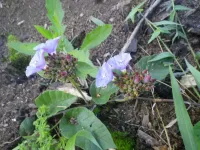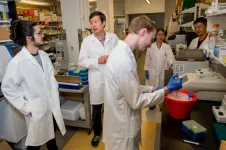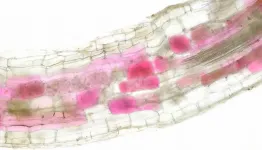(Press-News.org) Rivers are lifelines for many countries. They create valuable ecosystems, provide drinking water for people and raw water for agriculture and industry. In the Global South in particular, there is strong competition for access to freshwater resources. The increasing use of hydropower has recently intensified this competition further.
Take Ethiopia, for example: when the country began filling the mega-?dam Gibe III on the Omo River in 2015, downstream users saw a drop in water volumes. Natural flooding declined, reducing the volume of fertile mud washed onto the floodplain. The level of Kenya's Lake Turkana, into which the Omo flows, fell temporarily by two metres, resulting in significant consequences for people and agriculture.
Addressing the nexus
The network of interactions between water, energy, food and ecosystems - referred to by experts as the "water-energy-food (WEF) nexus" - often leads to wide-ranging disputes in the catchment areas of transboundary rivers. Large-scale infrastructure construction projects such as dams and irrigation schemes have caused political tensions between neighbouring states at various points in the past.
An international research team led by ETH Zurich has now developed a strategic toolkit that can help to defuse such conflicts over water use, through an objective analysis of stakeholder's interests. In the EU's Horizon 2020 project DAFNE, 14 research partners from Europe and Africa worked together to find approaches to a more equitable management of water resources.
"We wanted to show how it is possible to sustainably manage the nexus between water, energy, food and ecosystems, even in large and transboundary river basins with a wide range of users," says Paolo Burlando, Professor of Hydrology and Water Resources Management at ETH Zurich.
Integrating and balancing different interests
While it is now recognised that watershed planning should take a holistic approach that respects the needs of all stakeholders, multidimensional decision-making problems with significant numbers of stakeholders make it difficult to negotiate generally accepted solutions.
"Conventional planning tools are usually overwhelmed with challenges such as these," explains Burlando, who has led the DAFNE consortium for the past four years. This is why the project team developed a novel method to map and quantify trade-offs in the WEF nexus.
The approach is based on the principles of the participatory and integrated planning and management of water resources, which focuses on the role and interests of stakeholders. The DAFNE methodology is designed to engage stakeholders and find compromises and synergies in a joint approach. "The key is to find solutions that benefit everyone, take the environment into account and also make economic sense," explains Burlando.
Enabling dialogue through models
DAFNE uses state-of-the-art modelling techniques and digital solutions to enable participatory planning. A strategic decision tool allows the social, economic and environmental consequences of interventions to be assessed in a quantitative approach, enabling users to identify viable development pathways. Stakeholder selected pathways are simulated in detail using a hydrological model driven by high-resolution climate scenarios, in order to accurately analyse the impact on the respective water resources. Additional sub-models can be used to model other aspects of the nexus. Finally, a visualisation tool helps to illustrate interrelationships and assess problems from various user perspectives.
"The models aim to facilitate continuous negotiation between stakeholders - which is a key element of the DAFNE approach," says Senior Scientist Scott Sinclair, who co-developed the modelling approach.
Case studies with local stakeholders
The DAFNE project focused on two large river basins in East, and Southern Africa - the Omo-Turkana and Zambezi - where the researchers tested their methodology in two case studies. In both case studies, real stakeholders were involved in the development of the DAFNE approaches, working with them to test alternative operating modes for the power plants and irrigation schemes, to design more sustainable use scenarios for their catchment areas. They exchanged their different perspectives in simulated negotiations to illustrate the process.
In the Omo-Turkana basin, the scientists also used their methodology in a retrospective analysis of the controversial two-year filling phase of the Gibe III mega-dam in Ethiopia. "We observed that the negative impact on downstream neighbours was exacerbated by a prolonged drought," reports Burlando. The DAFNE consortium partner from Politecnico di Milano were able to show in a study published in Nature Communications together with Burlando and Sinclair, that such problems can be reduced by combining DAFNE tools with seasonal drought forecasts and flexibly adapting the filling regime to hydroclimatic conditions.
Dams on the advance worldwide
The results of the study are highly topical: Ethiopia is currently building another mega-dam in the Omo-Turkana catchment area, and filling the Grand Ethiopian Renaissance Dam on the Blue Nile. Worldwide, around 500 dam projects are being planned in regions affected by climate feedbacks through teleconnections. Growing populations and increasing prosperity will continue to boost demand for energy, food and water. The researchers hope that the DAFNE methodology will one day become a reference.
"We designed the modelling tools to be transferable to other regions with competing water needs," says Burlando. Follow-up projects are already under way to apply and further develop the technology in several river basins worldwide.
INFORMATION:
Reference
Zaniolo M, Giuliani M, Sinclair S, Burlando P, Castelletti A. When timing matters - misdesigned dam filling impacts hydropower sustainability. Nat Commun 12, 3056 (2021), doi: 10.1038/s41467-021-23323-5
Scientists have identified five new plant species in the Bolivian Andes.
The species are all part of the genus Jacquemontia, which are twining or trailing plants with pretty blue flowers.
With rapid biodiversity loss taking place across South America and worldwide, identifying plant species is a vital step towards protecting them.
The new study, which classifies and describes the 28 Jacquemontia species now known to live in Bolivia and Peru, was carried out by the universities of Exeter and Oxford, and the Royal Botanic Gardens, Kew.
"Many plant species have not been identified and classified, especially in the tropics," said Rosie Clegg, of the University of Exeter and Kew.
"If you don't know what a species is, you can't ...
Most children with a mental health disorder are not receiving services to address their needs--according to a new study from researchers at Simon Fraser University's Children's Health Policy Centre. Their research was published this week in the journal Evidence-Based Mental Health.
Researchers found that of the one in eight children (12.7 per cent) who experience a mental disorder, less than half (44.2 per cent) receive any services for these conditions.
"We have illuminated an invisible crisis in children's mental health and unacceptable service shortfalls in high-income countries -- including in Canada -- to a degree that violates children's rights," says study author Charlotte Waddell, ...
After gaining world attention by 'unboiling' egg protein, Flinders University scientists have now used an Australian-made novel thin film microfluidic device to manipulate Beta-lactoglobulin (β-lactoglobulin), the major whey protein in cow's, sheep's and other mammals.
The so-called Vortex Fluidic Device has previously been used in an array of experiments to successfully 'un-boil' egg protein and even break the molecular bonds of one of the world's hardest material, carbon nanotubes.
In the latest application, published in Molecules, College of Science and Engineering experts have combined the capabilities of the VFD with a new form of biosensor called TPE-MI, which is an aggregation-induced emission luminogen (AIEgen).
"In the human body, protein folding is ...
The human body is essentially made up of trillions of living cells. It ages as its cells age, which happens when those cells eventually stop replicating and dividing. Scientists have long known that genes influence how cells age and how long humans live, but how that works exactly remains unclear. Findings from a new study led by researchers at Washington State University have solved a small piece of that puzzle, bringing scientists one step closer to solving the mystery of aging.
A research team headed by Jiyue Zhu, a professor in the College of Pharmacy and Pharmaceutical Sciences, recently identified a DNA region known as VNTR2-1 that appears to drive the activity of the telomerase gene, which has been shown to prevent ...
Almost all crop plants form associations with a particular type of fungi - called arbuscular mycorrhiza fungi - in the soil, which greatly expand their root surface area. This mutually beneficial interaction boosts the plant's ability to take up nutrients that are vital for growth.
The more nutrients plants obtain naturally, the less artificial fertilisers are needed. Understanding this natural process, as the first step towards potentially enhancing it, is an ongoing research challenge. Progress is likely to pay huge dividends for agricultural productivity.
In a study published in the journal PLOS Biology, researchers used the bright red pigments of beetroot - called betalains - to visually track soil fungi as they colonised plant roots in a living plant.
"We can now ...
Many disease-causing bacteria such as Pseudomonas aeruginosa crawl on surfaces through a walk-like motility known as "twitching". Nanometers-wide filaments called type IV pili are known to power twitching, but scientists ignore which sensory signals coordinate the microbes' movements.
Now, EPFL researchers have found that Pseudomonas bacteria use a mechanism similar to our sense of touch to navigate on surfaces. "This study changes the way we think about motility in bacteria," says senior author Alexandre Persat, a tenure track assistant professor at EPFL's School of Life Sciences.
Scientists have known that ...
Oncotarget published "Role for Fgr and Numb in retinoic acid-induced differentiation and G0 arrest of non-APL AML cells" which reported that retinoic acid is a fundamental regulator of cell cycle and cell differentiation.
Using a leukemic patient-derived in vitro model of a non-APL AML, these authors previously found that RA evokes activation of a macromolecular signaling complex, a signalosome, built of numerous MAPK-pathway-related signaling molecules; and this signaling enabled Retinoic-Acid-Response-Elements to regulate gene expression that results in cell differentiation/cell cycle arrest. Toward mechanistic ...
Researchers from George Mason University, University of Manitoba, Colorado State University, and Georgetown University published a new paper in the Journal of Marketing that examines an unintended customer consequence of lobbying, decreased customer satisfaction, and also explains marketing-focused efforts that can help prevent it.
The study, forthcoming in the the Journal of Marketing, is titled "Shedding Light on the Dark Side of Firm Lobbying: A Customer Perspective" and is authored by Gautham Vadakkepatt, Sandeep Arora, Kelly Martin, and Neeru Paharia.
Lobbying, ...
A network of over 100 herbaria spread out across the southeastern United States recently completed the herculean task of fully digitizing more than three million specimens collected by botanists and naturalists over a span of 200 years. The project, which was funded by the National Science Foundation, is part of a larger, ongoing effort by natural history institutions worldwide to make their biological collections easily accessible to researchers studying broad patterns of evolution, extinction, range shifts, and climate change.
In a END ...
A team at the Natural History Museum (NHM), London is paving the way for future rovers to search for meteorites on Mars. The scientists are using the NHM's extensive meteorite collection to test the spectral instruments destined for the ExoMars rover Rosalind Franklin, and develop tools to identify meteorites on the surface of the red planet. The project is being presented today (23 July) at the virtual National Astronomy Meeting 2021.
The cratered surface of our nearest planetary neighbour has a long and complex history, and searching for rocks amidst more rocks may seem like a futile activity. Despite this, Martian rovers statistically have a significantly higher 'find per mile' success rate than dedicated meteorite hunts on ...







